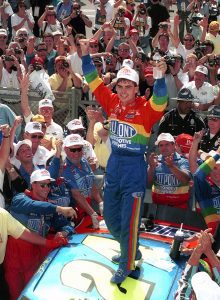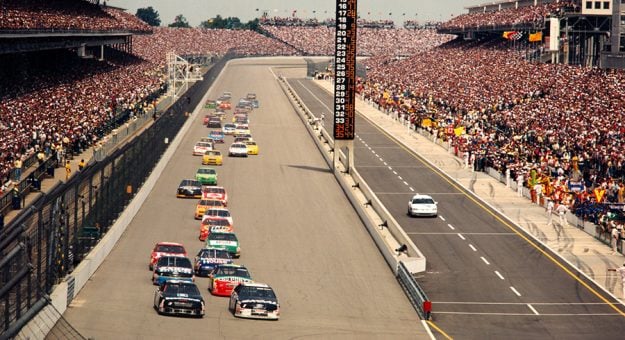The inaugural Brickyard 400 stands out as possibly the best among the 27 editions of the event because of the amazing build-up that surrounded the first-time event. Requests for tickets were estimated at four times the number that could be filled. That, coupled with Gordon’s victory, puts the 1994 race at the top of the list.
The second greatest Brickyard 400 finish was in 1996 when Dale Jarrett passed his Robert Yates Racing teammate Ernie Irvan for the lead with seven laps remaining.
It was also the year Jarrett spontaneously kissed the bricks with his crew and started a tradition that has stood the test of time.
“It’s something that just sort of happened and I’m so honored that everyone still does it since we started it in 1996,” Jarrett said. “The win was so special to us. (Crew chief) Todd Parrott and I talked about doing something if we won the race. So after the victory lane ceremony was over, we walked out to the start-finish line, just the two of us at first, and kissed the bricks. Then the entire crew came out and joined us.”
A third memorable victory came when Team Penske’s Brad Keselowski won the Brickyard 400 in 2018. The victory gave team owner Roger Penske, who has won the Indianapolis 500 a record 18 times, his first NASCAR triumph at Indy.
Significant tire issues plagued the 2008 running of the Brickyard 400, resulting in 11 yellow flags and attendance for the event has struggled since then. In recent years, the race was moved to September from its traditional early August date, and last year, was run on July Fourth weekend.
It may have been the final NASCAR Cup Series race on the legendary Indianapolis oval.

When this year’s rebadged Verizon 200 at the Brickyard takes the green flag on Aug. 15, it will be run on the 14-turn, 2.439-mile road course at Indianapolis Motor Speedway for the first time.
“I think it spoke volumes for the popularity that NASCAR was enjoying all over the country then,” Gordon said about the early years of the Brickyard race. “As the cars evolved, they just haven’t put on the best show. Indy cars and the way they have downforce and how they are designed, they can put on a good race designed like that. NASCAR needs to put on a close show that we are known for.
“So even though I loved driving the track, there are difficulties of trying to pass because of the aerodynamics with the one-lane race track. I can see why they would want to shake it up. It’s still cool to want to go to Indianapolis and contend at that race track because it still carries a ton of prestige. If the fans are going to see a better show by it being on the road course, then I support it.”
Ricky Craven, a former Cup Series driver who entered 10 Brickyard 400s from 1995 through 2004, offers an interesting assessment of Cup Series racing at Indianapolis.
“I’ve often thought the sweet spot for NASCAR was the 1990s,” Craven said. “There’s no doubt in my mind about that. The highwater mark measuring several different ways and answering a question with a question is, ‘Did Indianapolis Motor Speedway need NASCAR or did NASCAR need Indianapolis Motor Speedway?’
“I feel somebody created or marketed the idea and I totally believe Indy felt that they needed us because NASCAR was the greatest and hottest thing going.
“The success of NASCAR was enormous in 1994. There was intrigue. There was curiosity, as if to say, ‘We know what the Indy 500 is to motorsports.’ We know because A.J. and Al Unser Sr. and Rick Mears — they all gave it to us. There had to be demand and intrigue for Earnhardt, Gordon, Wallace, Bill Elliott, Mark Martin — we can go on and on. It was new and different. NASCAR at Indy was a huge success.”
